AC 5004: Analyzing Tax Avoidance & Evasion Strategies in the UK
VerifiedAdded on 2023/04/22
|8
|1529
|385
Essay
AI Summary
This essay provides a detailed analysis of the tax gap, tax avoidance, and tax evasion within the UK's financial landscape. It begins by defining the tax gap as the difference between owed and paid taxes, further differentiating between tax avoidance (legal methods to reduce tax liability) and tax evasion (illegal means of avoiding taxes). The essay explores strategies employed by individuals and companies for tax avoidance, such as transfer pricing and utilizing controlled foreign companies. Furthermore, it discusses the steps taken by the UK government and HMRC to minimize tax avoidance, including measures like diverted profit taxes, anti-avoidance requirements, and mandatory disclosure rules. The conclusion emphasizes the importance of curbing tax fraud for economic prosperity and suggests imposing penalties and imprisonment for tax evaders.
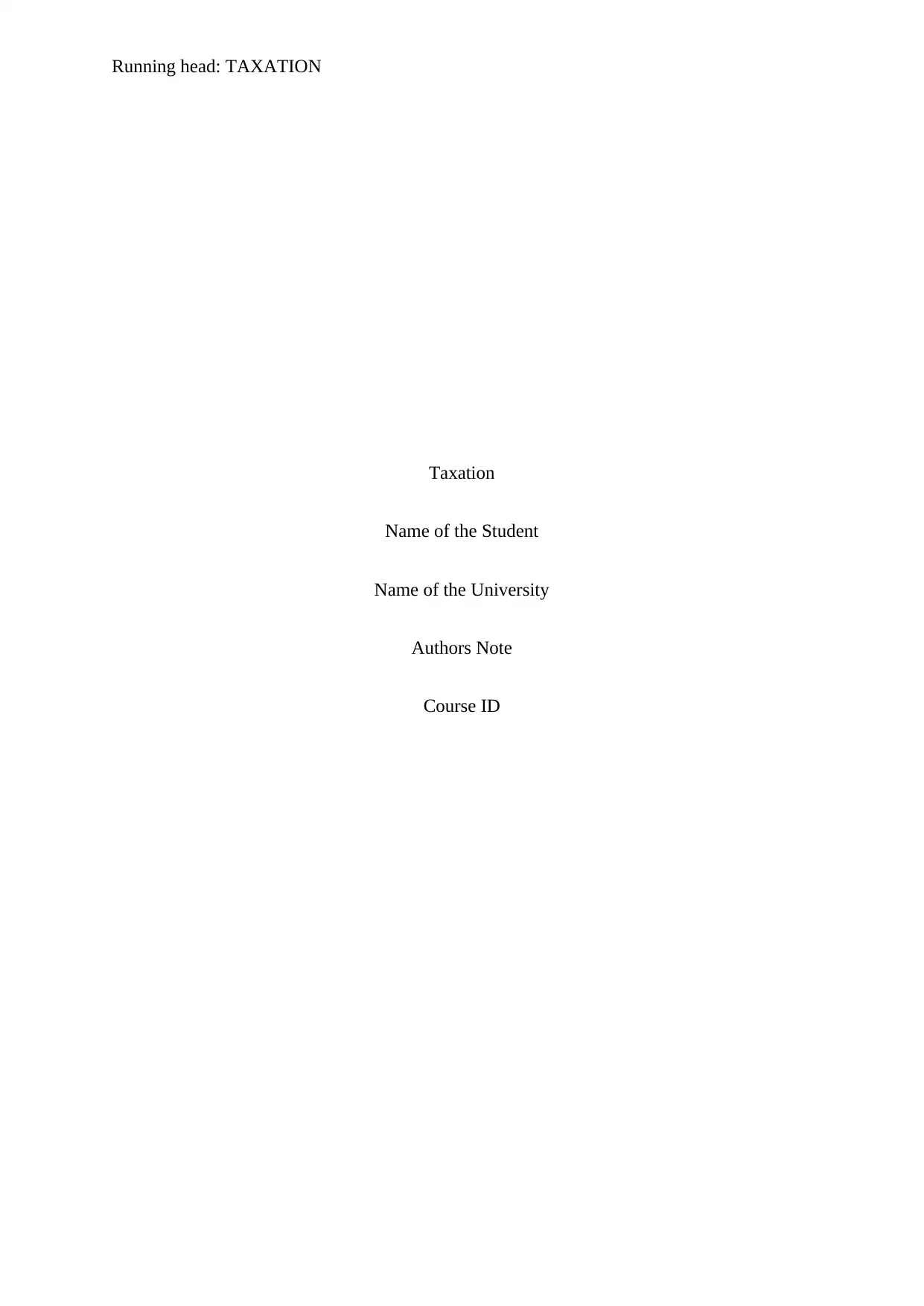
Running head: TAXATION
Taxation
Name of the Student
Name of the University
Authors Note
Course ID
Taxation
Name of the Student
Name of the University
Authors Note
Course ID
Paraphrase This Document
Need a fresh take? Get an instant paraphrase of this document with our AI Paraphraser
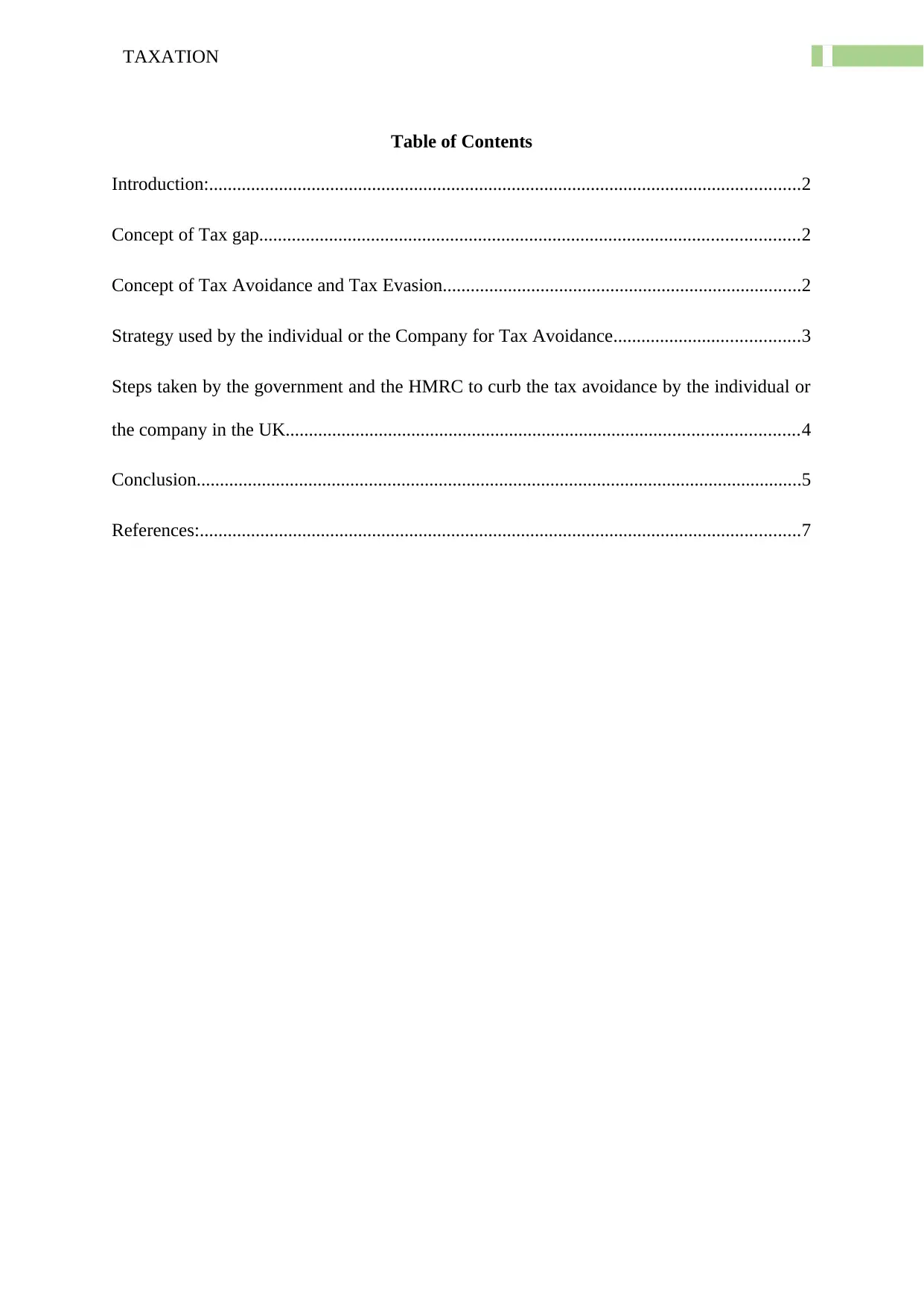
1TAXATION
Table of Contents
Introduction:...............................................................................................................................2
Concept of Tax gap....................................................................................................................2
Concept of Tax Avoidance and Tax Evasion.............................................................................2
Strategy used by the individual or the Company for Tax Avoidance........................................3
Steps taken by the government and the HMRC to curb the tax avoidance by the individual or
the company in the UK..............................................................................................................4
Conclusion..................................................................................................................................5
References:.................................................................................................................................7
Table of Contents
Introduction:...............................................................................................................................2
Concept of Tax gap....................................................................................................................2
Concept of Tax Avoidance and Tax Evasion.............................................................................2
Strategy used by the individual or the Company for Tax Avoidance........................................3
Steps taken by the government and the HMRC to curb the tax avoidance by the individual or
the company in the UK..............................................................................................................4
Conclusion..................................................................................................................................5
References:.................................................................................................................................7
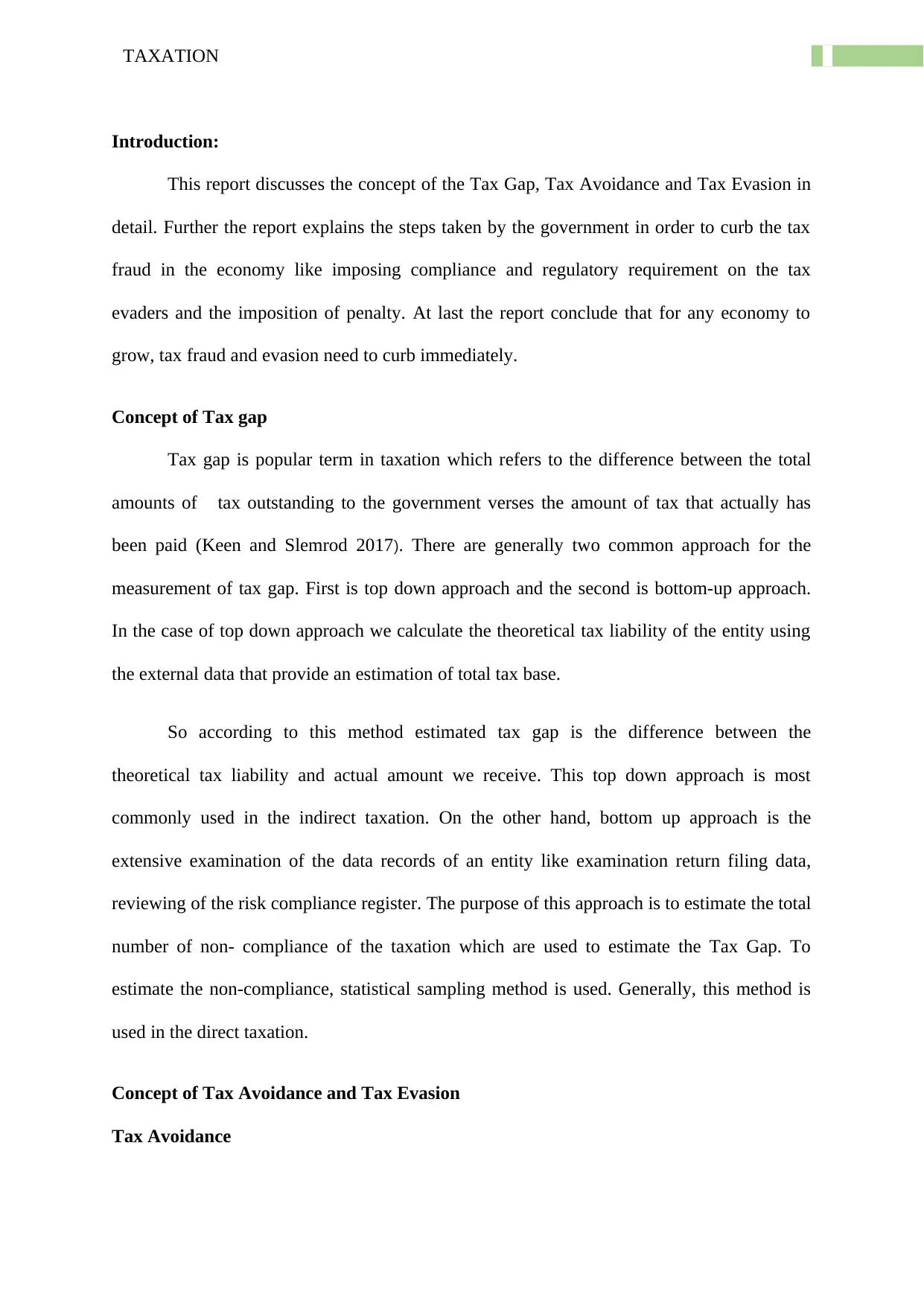
2TAXATION
Introduction:
This report discusses the concept of the Tax Gap, Tax Avoidance and Tax Evasion in
detail. Further the report explains the steps taken by the government in order to curb the tax
fraud in the economy like imposing compliance and regulatory requirement on the tax
evaders and the imposition of penalty. At last the report conclude that for any economy to
grow, tax fraud and evasion need to curb immediately.
Concept of Tax gap
Tax gap is popular term in taxation which refers to the difference between the total
amounts of tax outstanding to the government verses the amount of tax that actually has
been paid (Keen and Slemrod 2017). There are generally two common approach for the
measurement of tax gap. First is top down approach and the second is bottom-up approach.
In the case of top down approach we calculate the theoretical tax liability of the entity using
the external data that provide an estimation of total tax base.
So according to this method estimated tax gap is the difference between the
theoretical tax liability and actual amount we receive. This top down approach is most
commonly used in the indirect taxation. On the other hand, bottom up approach is the
extensive examination of the data records of an entity like examination return filing data,
reviewing of the risk compliance register. The purpose of this approach is to estimate the total
number of non- compliance of the taxation which are used to estimate the Tax Gap. To
estimate the non-compliance, statistical sampling method is used. Generally, this method is
used in the direct taxation.
Concept of Tax Avoidance and Tax Evasion
Tax Avoidance
Introduction:
This report discusses the concept of the Tax Gap, Tax Avoidance and Tax Evasion in
detail. Further the report explains the steps taken by the government in order to curb the tax
fraud in the economy like imposing compliance and regulatory requirement on the tax
evaders and the imposition of penalty. At last the report conclude that for any economy to
grow, tax fraud and evasion need to curb immediately.
Concept of Tax gap
Tax gap is popular term in taxation which refers to the difference between the total
amounts of tax outstanding to the government verses the amount of tax that actually has
been paid (Keen and Slemrod 2017). There are generally two common approach for the
measurement of tax gap. First is top down approach and the second is bottom-up approach.
In the case of top down approach we calculate the theoretical tax liability of the entity using
the external data that provide an estimation of total tax base.
So according to this method estimated tax gap is the difference between the
theoretical tax liability and actual amount we receive. This top down approach is most
commonly used in the indirect taxation. On the other hand, bottom up approach is the
extensive examination of the data records of an entity like examination return filing data,
reviewing of the risk compliance register. The purpose of this approach is to estimate the total
number of non- compliance of the taxation which are used to estimate the Tax Gap. To
estimate the non-compliance, statistical sampling method is used. Generally, this method is
used in the direct taxation.
Concept of Tax Avoidance and Tax Evasion
Tax Avoidance
⊘ This is a preview!⊘
Do you want full access?
Subscribe today to unlock all pages.

Trusted by 1+ million students worldwide
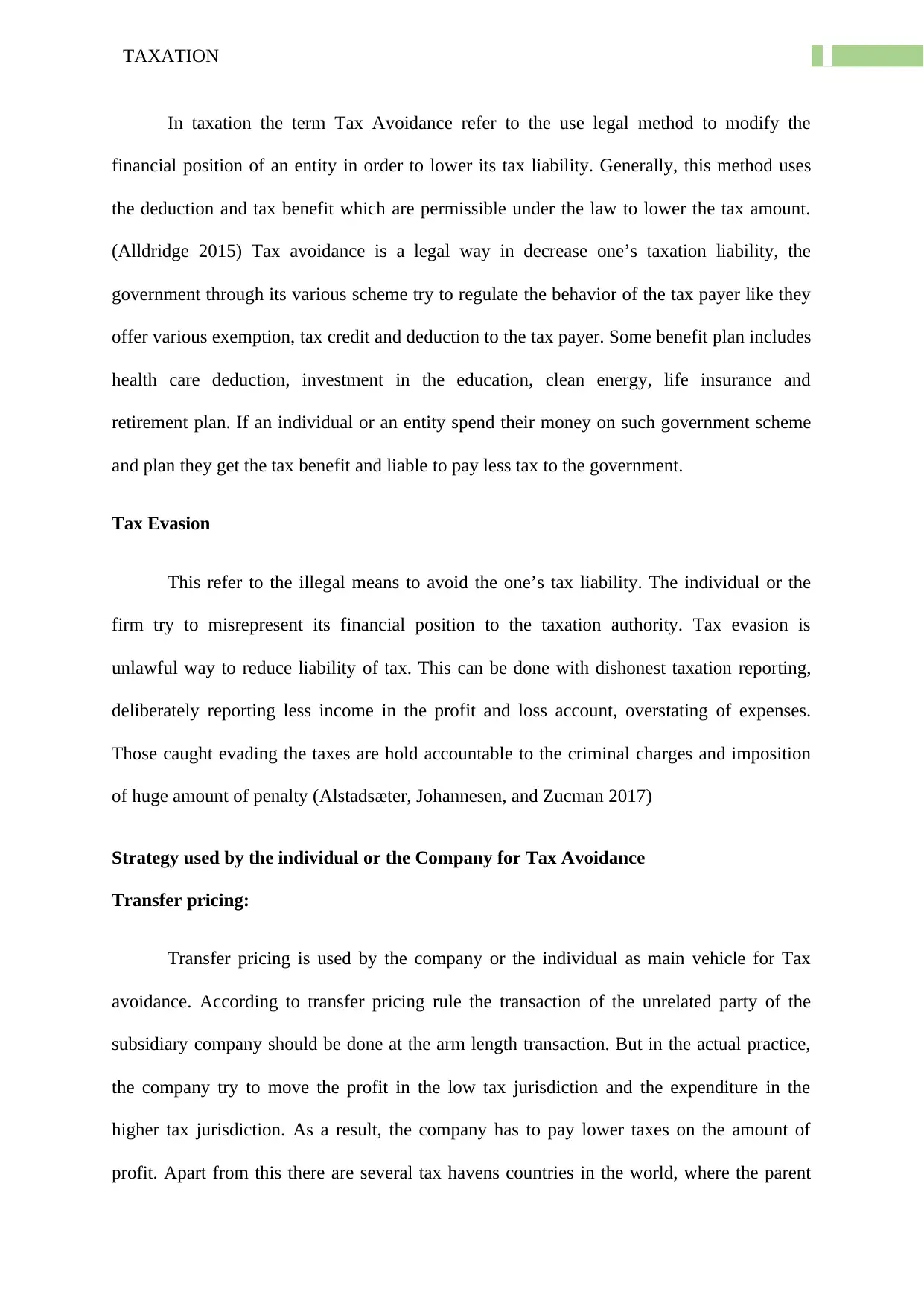
3TAXATION
In taxation the term Tax Avoidance refer to the use legal method to modify the
financial position of an entity in order to lower its tax liability. Generally, this method uses
the deduction and tax benefit which are permissible under the law to lower the tax amount.
(Alldridge 2015) Tax avoidance is a legal way in decrease one’s taxation liability, the
government through its various scheme try to regulate the behavior of the tax payer like they
offer various exemption, tax credit and deduction to the tax payer. Some benefit plan includes
health care deduction, investment in the education, clean energy, life insurance and
retirement plan. If an individual or an entity spend their money on such government scheme
and plan they get the tax benefit and liable to pay less tax to the government.
Tax Evasion
This refer to the illegal means to avoid the one’s tax liability. The individual or the
firm try to misrepresent its financial position to the taxation authority. Tax evasion is
unlawful way to reduce liability of tax. This can be done with dishonest taxation reporting,
deliberately reporting less income in the profit and loss account, overstating of expenses.
Those caught evading the taxes are hold accountable to the criminal charges and imposition
of huge amount of penalty (Alstadsæter, Johannesen, and Zucman 2017)
Strategy used by the individual or the Company for Tax Avoidance
Transfer pricing:
Transfer pricing is used by the company or the individual as main vehicle for Tax
avoidance. According to transfer pricing rule the transaction of the unrelated party of the
subsidiary company should be done at the arm length transaction. But in the actual practice,
the company try to move the profit in the low tax jurisdiction and the expenditure in the
higher tax jurisdiction. As a result, the company has to pay lower taxes on the amount of
profit. Apart from this there are several tax havens countries in the world, where the parent
In taxation the term Tax Avoidance refer to the use legal method to modify the
financial position of an entity in order to lower its tax liability. Generally, this method uses
the deduction and tax benefit which are permissible under the law to lower the tax amount.
(Alldridge 2015) Tax avoidance is a legal way in decrease one’s taxation liability, the
government through its various scheme try to regulate the behavior of the tax payer like they
offer various exemption, tax credit and deduction to the tax payer. Some benefit plan includes
health care deduction, investment in the education, clean energy, life insurance and
retirement plan. If an individual or an entity spend their money on such government scheme
and plan they get the tax benefit and liable to pay less tax to the government.
Tax Evasion
This refer to the illegal means to avoid the one’s tax liability. The individual or the
firm try to misrepresent its financial position to the taxation authority. Tax evasion is
unlawful way to reduce liability of tax. This can be done with dishonest taxation reporting,
deliberately reporting less income in the profit and loss account, overstating of expenses.
Those caught evading the taxes are hold accountable to the criminal charges and imposition
of huge amount of penalty (Alstadsæter, Johannesen, and Zucman 2017)
Strategy used by the individual or the Company for Tax Avoidance
Transfer pricing:
Transfer pricing is used by the company or the individual as main vehicle for Tax
avoidance. According to transfer pricing rule the transaction of the unrelated party of the
subsidiary company should be done at the arm length transaction. But in the actual practice,
the company try to move the profit in the low tax jurisdiction and the expenditure in the
higher tax jurisdiction. As a result, the company has to pay lower taxes on the amount of
profit. Apart from this there are several tax havens countries in the world, where the parent
Paraphrase This Document
Need a fresh take? Get an instant paraphrase of this document with our AI Paraphraser
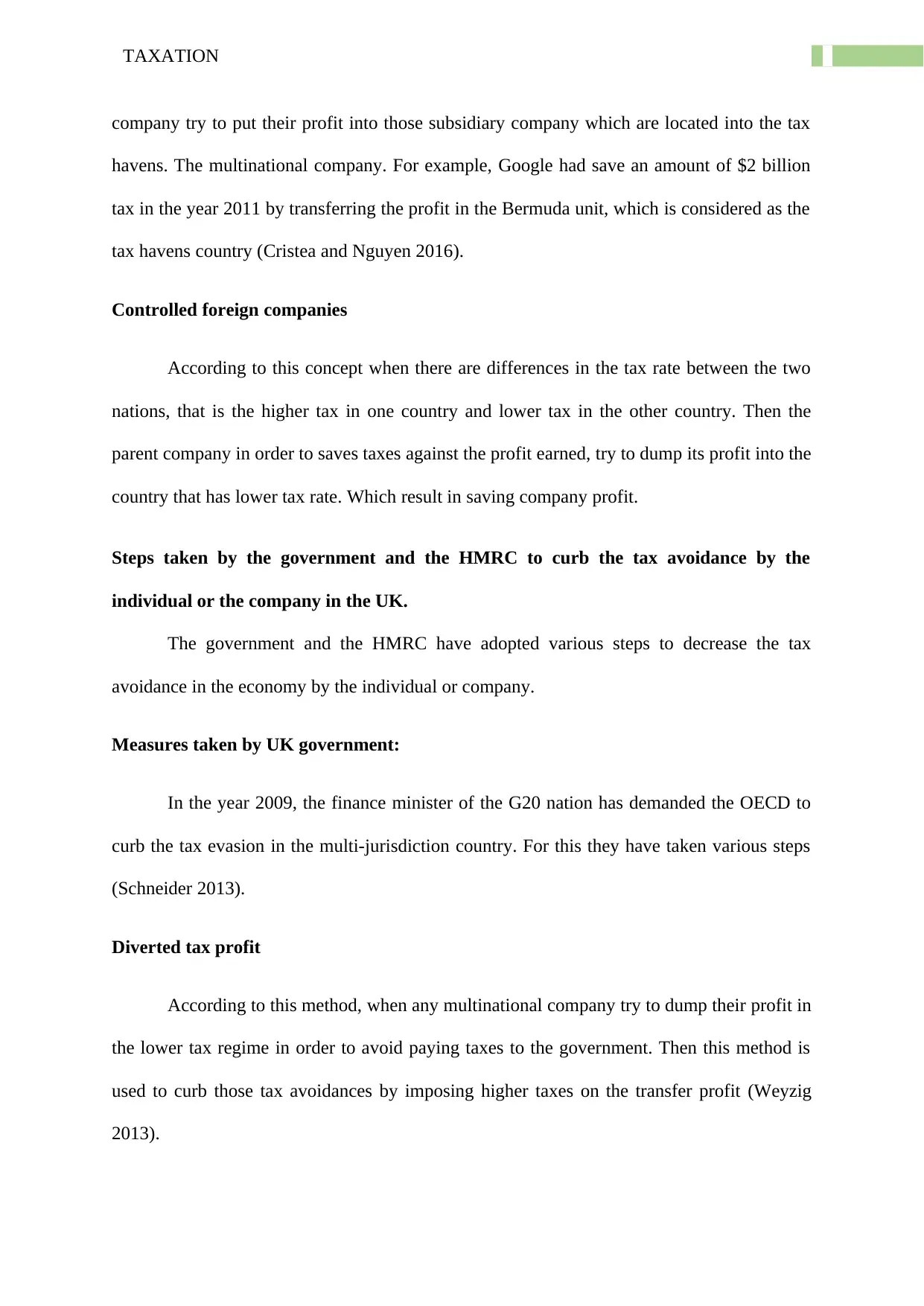
4TAXATION
company try to put their profit into those subsidiary company which are located into the tax
havens. The multinational company. For example, Google had save an amount of $2 billion
tax in the year 2011 by transferring the profit in the Bermuda unit, which is considered as the
tax havens country (Cristea and Nguyen 2016).
Controlled foreign companies
According to this concept when there are differences in the tax rate between the two
nations, that is the higher tax in one country and lower tax in the other country. Then the
parent company in order to saves taxes against the profit earned, try to dump its profit into the
country that has lower tax rate. Which result in saving company profit.
Steps taken by the government and the HMRC to curb the tax avoidance by the
individual or the company in the UK.
The government and the HMRC have adopted various steps to decrease the tax
avoidance in the economy by the individual or company.
Measures taken by UK government:
In the year 2009, the finance minister of the G20 nation has demanded the OECD to
curb the tax evasion in the multi-jurisdiction country. For this they have taken various steps
(Schneider 2013).
Diverted tax profit
According to this method, when any multinational company try to dump their profit in
the lower tax regime in order to avoid paying taxes to the government. Then this method is
used to curb those tax avoidances by imposing higher taxes on the transfer profit (Weyzig
2013).
company try to put their profit into those subsidiary company which are located into the tax
havens. The multinational company. For example, Google had save an amount of $2 billion
tax in the year 2011 by transferring the profit in the Bermuda unit, which is considered as the
tax havens country (Cristea and Nguyen 2016).
Controlled foreign companies
According to this concept when there are differences in the tax rate between the two
nations, that is the higher tax in one country and lower tax in the other country. Then the
parent company in order to saves taxes against the profit earned, try to dump its profit into the
country that has lower tax rate. Which result in saving company profit.
Steps taken by the government and the HMRC to curb the tax avoidance by the
individual or the company in the UK.
The government and the HMRC have adopted various steps to decrease the tax
avoidance in the economy by the individual or company.
Measures taken by UK government:
In the year 2009, the finance minister of the G20 nation has demanded the OECD to
curb the tax evasion in the multi-jurisdiction country. For this they have taken various steps
(Schneider 2013).
Diverted tax profit
According to this method, when any multinational company try to dump their profit in
the lower tax regime in order to avoid paying taxes to the government. Then this method is
used to curb those tax avoidances by imposing higher taxes on the transfer profit (Weyzig
2013).
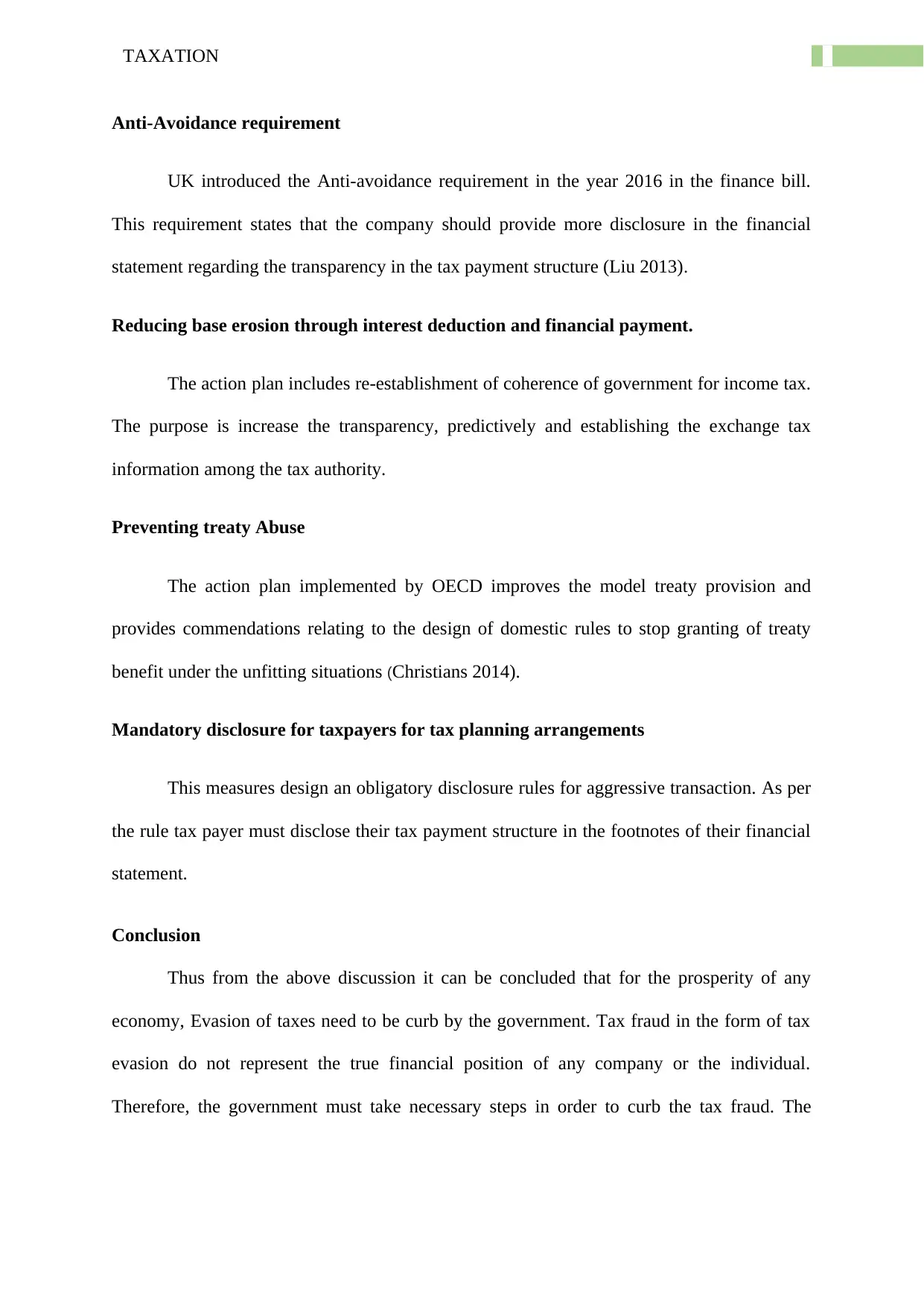
5TAXATION
Anti-Avoidance requirement
UK introduced the Anti-avoidance requirement in the year 2016 in the finance bill.
This requirement states that the company should provide more disclosure in the financial
statement regarding the transparency in the tax payment structure (Liu 2013).
Reducing base erosion through interest deduction and financial payment.
The action plan includes re-establishment of coherence of government for income tax.
The purpose is increase the transparency, predictively and establishing the exchange tax
information among the tax authority.
Preventing treaty Abuse
The action plan implemented by OECD improves the model treaty provision and
provides commendations relating to the design of domestic rules to stop granting of treaty
benefit under the unfitting situations (Christians 2014).
Mandatory disclosure for taxpayers for tax planning arrangements
This measures design an obligatory disclosure rules for aggressive transaction. As per
the rule tax payer must disclose their tax payment structure in the footnotes of their financial
statement.
Conclusion
Thus from the above discussion it can be concluded that for the prosperity of any
economy, Evasion of taxes need to be curb by the government. Tax fraud in the form of tax
evasion do not represent the true financial position of any company or the individual.
Therefore, the government must take necessary steps in order to curb the tax fraud. The
Anti-Avoidance requirement
UK introduced the Anti-avoidance requirement in the year 2016 in the finance bill.
This requirement states that the company should provide more disclosure in the financial
statement regarding the transparency in the tax payment structure (Liu 2013).
Reducing base erosion through interest deduction and financial payment.
The action plan includes re-establishment of coherence of government for income tax.
The purpose is increase the transparency, predictively and establishing the exchange tax
information among the tax authority.
Preventing treaty Abuse
The action plan implemented by OECD improves the model treaty provision and
provides commendations relating to the design of domestic rules to stop granting of treaty
benefit under the unfitting situations (Christians 2014).
Mandatory disclosure for taxpayers for tax planning arrangements
This measures design an obligatory disclosure rules for aggressive transaction. As per
the rule tax payer must disclose their tax payment structure in the footnotes of their financial
statement.
Conclusion
Thus from the above discussion it can be concluded that for the prosperity of any
economy, Evasion of taxes need to be curb by the government. Tax fraud in the form of tax
evasion do not represent the true financial position of any company or the individual.
Therefore, the government must take necessary steps in order to curb the tax fraud. The
⊘ This is a preview!⊘
Do you want full access?
Subscribe today to unlock all pages.

Trusted by 1+ million students worldwide
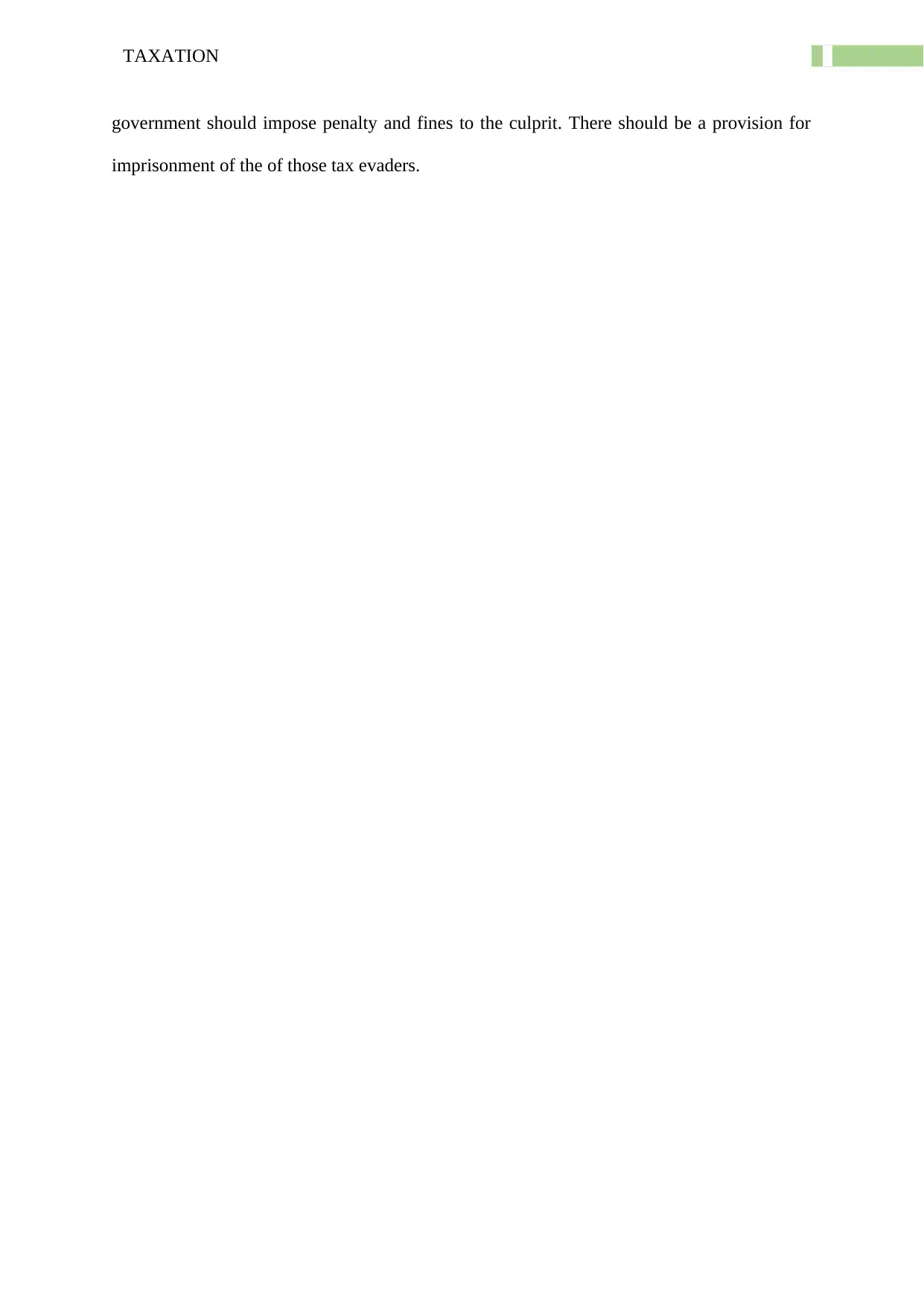
6TAXATION
government should impose penalty and fines to the culprit. There should be a provision for
imprisonment of the of those tax evaders.
government should impose penalty and fines to the culprit. There should be a provision for
imprisonment of the of those tax evaders.
Paraphrase This Document
Need a fresh take? Get an instant paraphrase of this document with our AI Paraphraser
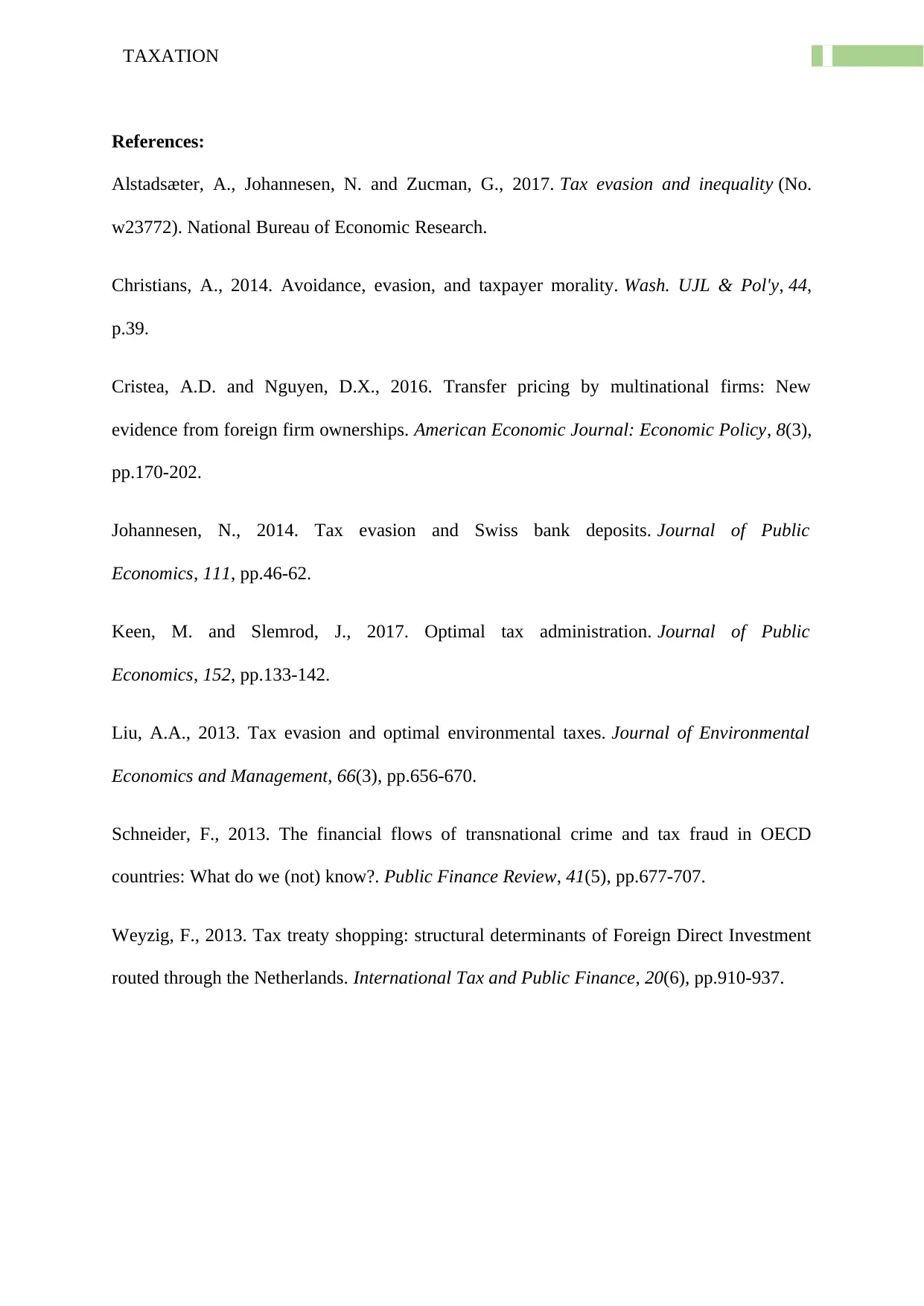
7TAXATION
References:
Alstadsæter, A., Johannesen, N. and Zucman, G., 2017. Tax evasion and inequality (No.
w23772). National Bureau of Economic Research.
Christians, A., 2014. Avoidance, evasion, and taxpayer morality. Wash. UJL & Pol'y, 44,
p.39.
Cristea, A.D. and Nguyen, D.X., 2016. Transfer pricing by multinational firms: New
evidence from foreign firm ownerships. American Economic Journal: Economic Policy, 8(3),
pp.170-202.
Johannesen, N., 2014. Tax evasion and Swiss bank deposits. Journal of Public
Economics, 111, pp.46-62.
Keen, M. and Slemrod, J., 2017. Optimal tax administration. Journal of Public
Economics, 152, pp.133-142.
Liu, A.A., 2013. Tax evasion and optimal environmental taxes. Journal of Environmental
Economics and Management, 66(3), pp.656-670.
Schneider, F., 2013. The financial flows of transnational crime and tax fraud in OECD
countries: What do we (not) know?. Public Finance Review, 41(5), pp.677-707.
Weyzig, F., 2013. Tax treaty shopping: structural determinants of Foreign Direct Investment
routed through the Netherlands. International Tax and Public Finance, 20(6), pp.910-937.
References:
Alstadsæter, A., Johannesen, N. and Zucman, G., 2017. Tax evasion and inequality (No.
w23772). National Bureau of Economic Research.
Christians, A., 2014. Avoidance, evasion, and taxpayer morality. Wash. UJL & Pol'y, 44,
p.39.
Cristea, A.D. and Nguyen, D.X., 2016. Transfer pricing by multinational firms: New
evidence from foreign firm ownerships. American Economic Journal: Economic Policy, 8(3),
pp.170-202.
Johannesen, N., 2014. Tax evasion and Swiss bank deposits. Journal of Public
Economics, 111, pp.46-62.
Keen, M. and Slemrod, J., 2017. Optimal tax administration. Journal of Public
Economics, 152, pp.133-142.
Liu, A.A., 2013. Tax evasion and optimal environmental taxes. Journal of Environmental
Economics and Management, 66(3), pp.656-670.
Schneider, F., 2013. The financial flows of transnational crime and tax fraud in OECD
countries: What do we (not) know?. Public Finance Review, 41(5), pp.677-707.
Weyzig, F., 2013. Tax treaty shopping: structural determinants of Foreign Direct Investment
routed through the Netherlands. International Tax and Public Finance, 20(6), pp.910-937.
1 out of 8
Related Documents
Your All-in-One AI-Powered Toolkit for Academic Success.
+13062052269
info@desklib.com
Available 24*7 on WhatsApp / Email
![[object Object]](/_next/static/media/star-bottom.7253800d.svg)
Unlock your academic potential
Copyright © 2020–2025 A2Z Services. All Rights Reserved. Developed and managed by ZUCOL.




